|
|
Click
to see video
|
 |
|
Illustration
27.
|
|
Video
of Coatrack
animation analysis
|
In order to actually
see all of the coatrack information seen in Duchamp's original studio
photograph in real 3D space, our eye would need to be moving in time
-- see Illustration 27 showing a video of Robert Slawinski and my animation.
Our analysis of the original coatrack depiction reveals that Duchamp
used a common composite photo trick to "cut and paste" together
his "whole" coatrack. Using 6 different photographs from 6
different fixed eye viewpoints, we believe that Duchamp cut out one
section of the coatrack from each photo and then carefully fused these
parts together for the final appearance of only one readymade coatrack.
The spectator would only "see" this actuality of multiple
points of sight "non-retinally," with conscious effort via
mental visualization or actual model-making.
We made both physical
and computer models here in the lab. Our computer animation diagrams
the 6 cuts we believe that Duchamp made from 6 separate photographs
taken in 6 different perspective positions. Robert Slawinski and my
analysis concludes that Duchamp used 3 whole hooks, 1 hook split into
2 parts and 1 whole wood board as the 6 parts (from 6 different photos)
as he assembled into what appears to be the single, whole and readymade
coatrack in his studio photograph. See Illustrations 28A, B, C, D, E,
F, the 6 coatrack parts that Duchamp cut out and later assembled together
are color coded (in these still images taken from the computer animation)
to emphasize the separation of the part selected by Duchamp from the
rest of the coatrack (that he then discards, and that follows the same
perspective geometry of the targeted part.)
|
click
each image to enlarge
|
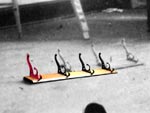 |
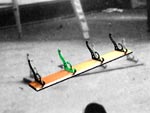 |
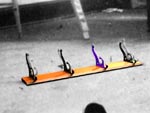 |
|
28A
|
28B
|
28C
|
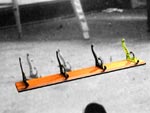 |
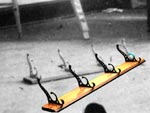 |
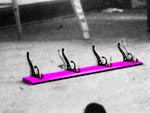 |
|
28D
|
28E
|
28F
|
This
series of stills shows each of the 6 coatrack positions
from which Duchamp selected parts to composite
(Note: The selected parts are color-coded)
|
Click
each
image to enlarge
|
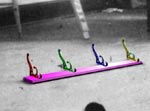 |
|
Illustration
29A.
A color-coded diagram showing the 6 parts
Duchamp composited together taken from 6 photos.
|
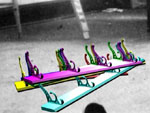 |
|
Illustration
29B.
|
|
This
still from our coatracks from which Duchamp selected parts to
composite (as in 29A).
|
Illustration 29A and
B show a comparison of the parts that Duchamp selected (in color coding)
with an image that assembles the 6 whole coatracks, in their 6 different
perspectives, together into one event simultaneously seen (using the
same color coding).
In addition to the
evidence resulting from our analysis of the perspective geometries,
2 other examples of internal evidence indicate that Duchamp used both
"masking" and "cut and paste" techniques from the
photo alterations used in hobby and trade.
|
Click
to enlarge
|
 |
|
Illustration
30.
|
|
A
photo trick book points to the problem of "fluffy contours"
created by the unintentionally cut and paste method, revealing
that photo compositing has been made.
|
Examine illustration
30, a close up view of Duchamp's original coatrack photo, revealing
what a photo trick book calls the "fluffy edges" that can
easily appear as a soft whitish outline around a photo cut-out after
being pasted, if special measures are not taken. Forensic experts look
for tell-tale signs -- such as fuzzy contours
-- as indicators that photo prints have been combined. See illustration
31A and B,two pages from "The Secrets of Trick Photography"
by O.R. Croy discussing this particular problem within the cut and paste
method.
|
Click
each
image to enlarge
|
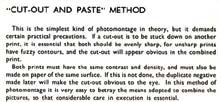 |
|
Illustration
31A.
|
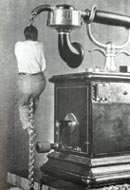 |
|
Illustration
31B.
|
|
Here
are two pages from a photo trick book discussion about the "cut
and paste" method used for creating photo composites.
|
Our second example
of internal evidence for our hypothesis that Duchamp altered his original
coatrack photograph by combining parts returns us to illustration 23E.
Only after making our animation analysis of the geometries in the coatrack
did I notice the potential importance of Duchamp's "working"
prints of the coatrack first published in 1983 by Ecke Bonk. These prints
were described by Bonk as preliminary stages of Duchamp's 1940 process
in preparing pochoir prints for his publication of 300 copies of the
Boîte-en-valise, (see illustration 32A and B). Bonk does
not explain what the method was, or why Duchamp was cutting and pasting
a separate paper cutout of the coatrack onto the background studio photo
(where 3 hooks are masked out of the scene with white). Illustration
32B indicates an attempt to position only the first hook of the cutout
onto the coatrack underneath. This "working print" also suggests
(as judged by their two positions) that the paper cut-out coatrack is
in one perspective view and the coatrack underneath, imbedded into the
studio photo background, is in another perspective.
|
Click
each
image to enlarge
|
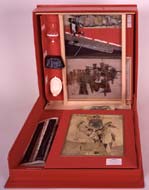 |
|
Illustration
32A.
|
|
Marcel
Duchamp, Boite-Series F, 1966
© 2000 Succession
Marcel Duchamp, ARS, N.Y./ADAGP, Paris
|
 |
|
Illustration
32B.
|
|
Working
print used by Duchamp to create his 1941 pochoir print for the
Boite-en-valise
|
 |
|
Illustration
32C.
|
|
A
still from our coatrack analysis that appears strikingly similar
to Duchamp's working print above
|
Compare this working
print (32B) to our still from the video animation, where we concluded
that Duchamp used 6 different viewpoints (cutouts of hooks and a wood
board from 6 photographs), see illustration 32C. The similarity between
32B and C is striking. Was Duchamp using the same method of compositing
multiple viewpoints into one coatrack for his pochoir print that he had
used earlier to create his original coatrack in the studio photograph?
I believe that this
working print serves as a "smoking gun" in our case. Not only
is the cut and paste method and the geometries of the forms similar
between the alterations in the studio photograph and in Duchamp's Boîte
pochoir print, but his separate white-out and maskings of the wood board
and the hooks now makes sense. For what purpose would the separate masking
and treatment of the 4 hooks and the wood base serve (as is clearly
indicated in his "working print") other than as a matrix for
creating a composite image?
Related to evidence
of photo compositing, as found within Duchamp's "working print"
of the coatrack, is a curious 2nd version of a photograph of Duchamp's
Fountain urinal taken by stieglitz in 1917, and shown in illustration
33A and B. William Camfield's 1989 book, a chronicle of the odd history
of Duchamp's Fountain urinal, presented this second stieglitz
photo for the first time after it quietly appeared within the archive
of Duchamp's main patrons, the Arensberg's, in the 1950's.
|
Click
each
image to enlarge
|
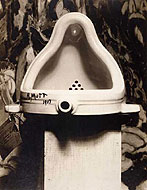 |
|
Illustration
33A.
|
|
Known
stieglitz version of Duchamp's Fountain urinal published
in
Blindman N. 2,1917
|
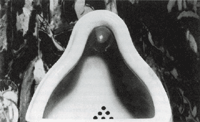 |
|
Illustration
33B.
|
|
Second
version of stieglitz's Fountain photo (1917) -- not publicly
known until 1989
|
Before discussing
the potential importance of this particular photograph, and its delayed
appearance for spectators, let us again examine, as we did with the
hatrack and coatrack, the consistent approach that Duchamp uses to present
his readymades -- as a series of snapshots over time -- now applied
to Duchamp's urinal.
As we discovered with his snow shovel, hatrack, coatrack, bicycle wheel
and stool, Duchamp's original 1917 urinal does not exist today. Historians
such as William Camfield and Michael Betancourt have documented the
contradictions and conflicting stories that leave us with effectively
no definitive evidence about the urinal's existence -- including any
potential witnesses of the object (the few testimonies that exist conflict);
who photographed it (stieglitz himself, who supposedly photographed
the urinal for the 1917 Blindman publication, only briefly mentions
the urinal in writing, and no negative or print was ever found in his
archive); or how it quickly the urinal vanished into thin air in 1917.
I will not go into the details here, for they are so well pursued and
documented by Camfield and Betancourt. All that we do have, as for Duchamp's
hatrack, coatrack, and other readymades, is a series of urinal representations
in 2D and 3D that we can put together in a set (as in step A of Duchamp's
mental operation). We can then examine each depiction as its own snapshot
or cut (as in Duchamp's step B, where we take separate observations
over time). Since the original 3D urinal is "lost" as a source
for collecting more information, we must depend upon our ability to
average among, and compare differences between, each urinal representation,
see illustrations 34A, B , C, D, E, F, G and H. The tally of our representations,
encompassing what we know of Duchamp's urinal, follows:
| 3 |
|
2D
photographs of 1917 original
(two by stieglitz and one by unknown photographer) |
| 2 |
|
3D
models
(one miniature and one full size) |
| 2 |
|
2D
prints
(one in 1941 Boîte, one 1964 etching) |
| 3 |
|
2D
Blueprints
(two side views, one plan view) |
|
Total cuts
|
| |
|
10
snapshots of the urinal
(eight 2D, two 3D)
|
|
click
each image to enlarge
Time Line of Readymade Series of Urinals -- As Seen by
Spectators
|
|
34A
|
34B
|
34C
|
34D
|
34E
|
34F
|
34G
|
34H
|
|
click
|
click
|
click
|
click
|
click
|
click
|
click
|
click
|
 |
 |
|
 |
 |
 |
 |

|
|
1917
|
1941
|
1941
|
1960s
(made 1916-17
found in 1960s)
|
1964
|
1964
|
1964
|
1989
(found
1950s
published 1989)
|
 |
|
2D
photo by stieglitz from Blindman #2 journal, 1917
|
3D
miniature
model
in
Boite-en
-valise
|
2D
print
made from
studio
photo in
Boite-en
valise
|
2D
photo, studio photo
|
2D
etching,
edition of 100
|
3D
pottery model Schwarz edition of 8,
second corrected version by Duchamp
|
2D
set of blueprints
(first 3D model,
based upon blueprints, lost)
|
2D
photo fragment published by William Camfield
(original dating not known)
|
|
Note: This time line excludes urinal versions that Duchamp
did not originate.
© 2000
Succession Marcel Duchamp, ARS, N.Y./ADAGP, Paris
|
|
As we discovered when
examining Duchampís hatrack and coatrack, the above set of urinal depictions
in 2D and 3D do not describe one consistent 3D urinal. For example,
our analysis of the studio photo 1916-17 (illustration 34D found in
the 1960's), the 1941 print (illustration 34C created from a 1916-17
photograph) and the 1st version of the stieglitz photograph
(illustration 34A published in the Blindman #2) reveals an inescapable
conclusion -- namely, that two different urinals were represented in
1917. Again, our key question involves casualty -- did Duchamp change
urinals literally or photographically? Evidence for both hypotheses
exists. Duchamp did make his original 3D miniature urinal model in 1940,
and he did commission others to manufacture the full edition of 300.
Surprisingly, after Duchamp authorized Schwarz to make editions of 14
of his "readymades," Schwarz failed, despite intensive search,
to find even one of the 14 mass produced objects close enough
to Duchampís originals in 2D or 3D to serve as prototypes for the editions.
Therefore, Schwarz had to organize the manufacture of all 14 editions
himself. Stranger still, no duplicate urinal has even been found in
any catalogue, including the literature from the very company that Duchamp
specifically named his source for his urinal -- the Mott company.
|